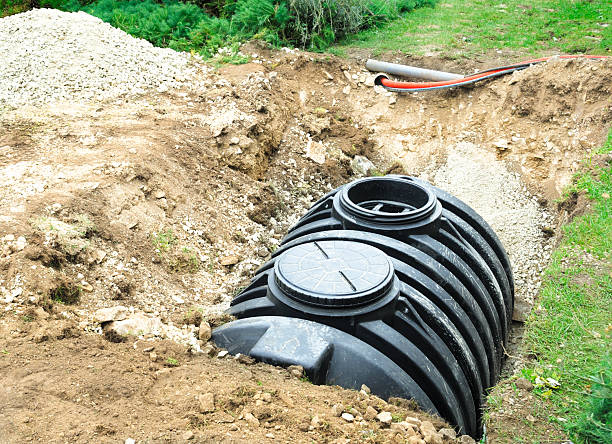If you’re planning a new home construction or considering property renovations, you might be exploring the world of septic system options. Often quietly hidden underground, Septic systems become crucial when public sewer systems are unavailable. They play a vital role in managing your home’s wastewater, including collection, treatment, and responsible disposal.
It’s important to understand that septic systems come in various forms, each with cost structures, complexities, maintenance requirements, and performance abilities.
In this blog post, we aim to simplify your decision-making process. We’ll provide a clear overview of popular septic system options, empowering you to make an informed choice for your home.
Common Septic System Types
Conventional Septic System
Conventional septic systems, often referred to as gravity systems, are the most common choice for wastewater management in areas without access to municipal sewage systems. These reliable systems consist of two main components: a septic tank and a drain field.
The process begins with wastewater entering the septic tank, where solid materials settle at the bottom and scum floats to the top. The liquid effluent then flows into the drain field, allowing it to gradually seep into the soil for further treatment. Conventional systems rely on the force of gravity to move wastewater through the system.
One notable advantage of conventional septic systems is their simplicity and cost-effectiveness. However, their suitability largely depends on the soil type and site conditions.
A proper soil test is crucial to determine if this traditional system is the right fit for your property, making it essential to consult a qualified septic system professional before installation.
Aerobic Treatment
Aerobic treatment units use oxygen to break down waste, making the wastewater cleaner than what traditional septic systems produce. This cleaner wastewater can go into a smaller drain field or even be released directly into a surface water body.
These units add oxygen to the treatment tank, helping good bacteria grow. Usually, they have two tanks: one for the first treatment step and another for the final one. These tanks are essential because they remove contaminants from the wastewater before it goes into the environment.
People choose aerobic systems when regular septic systems won’t work due to limited space or poor soil conditions. It’s important to note that aerobic systems are typically pricier, with costs ranging between $10,000 and $20,000, due to their use of more advanced technology.
Mound System
Mound systems offer an effective solution for properties dealing with challenges such as shallow or unsuitable soil, a high water table, or bedrock near the surface. These systems consist of a septic tank and a pump responsible for transporting wastewater to a specially constructed mound made of sand and gravel.
The purpose of this mound is straightforward: it acts as a natural filter for the wastewater, ensuring thorough purification before gentle release into the surrounding soil. This design overcomes the limitations posed by difficult soil conditions and proves particularly valuable in areas where traditional septic systems might struggle to function optimally.
Mound systems provide an efficient way to manage wastewater in environments that require a more specialized approach.
Chamber Systems
Chamber systems use a network of plastic chambers or pipes to evenly spread treated wastewater across a large area in the drain field. They’re efficient and work well for properties with limited space or tricky soil conditions.
What’s great about chamber systems is that they make sure the wastewater is distributed evenly, preventing any part from getting overloaded and helping the soil absorb it uniformly. This feature is especially useful when you have limited space or when the soil doesn’t cooperate with traditional systems.
Chamber systems are a practical and effective way to treat wastewater while being kind to the environment and your property.
Drip Distribution system
A drip distribution system represents a highly efficient and innovative approach to wastewater disposal and irrigation. Unlike traditional systems, which rely on large drain fields, this method delivers treated wastewater directly to the root zones of plants or soil through a network of tubing and emitters.
The process is precise and controlled, minimizing water wastage. By allowing small, controlled amounts of effluent to be released into the soil, this system ensures optimal nutrient absorption by plants. This makes it a sustainable choice for both wastewater management and irrigation needs.
Especially beneficial in areas with challenging soil conditions or limited space, the drip distribution system offers an environmentally friendly solution that aligns with modern conservation practices. It’s a testament to the continuous advancements in septic system technology.
Conclusion
Septic systems play a vital role in responsibly managing wastewater for homes without access to municipal sewer systems, safeguarding groundwater, surface water, and soil from contamination. It’s important to recognize the diversity among septic systems, each tailored to unique needs and preferences, as outlined above. Their differences encompass design, installation, operation, and maintenance, underscoring the importance of selecting the right system for your home.
Ready to make the right choice for your septic system needs? Don’t go it alone. Reach out to our team of seasoned professionals at VI REEL today. We specialize in septic system installation and have the knowledge and experience to guide you through the array of options available. Don’t take chances with your investment. Let us help you select the perfect septic system for your property. Contact us now for expert advice and worry-free septic system solutions.


